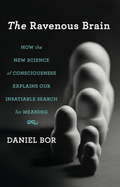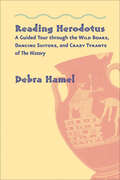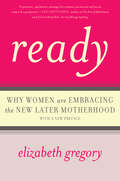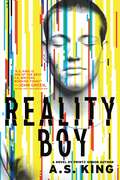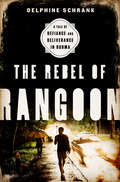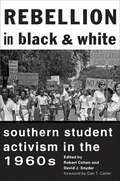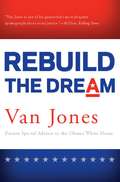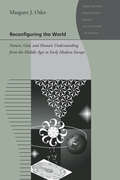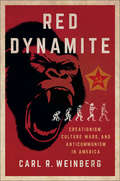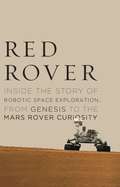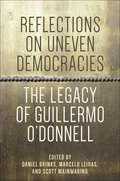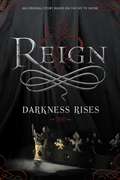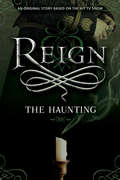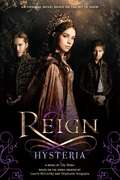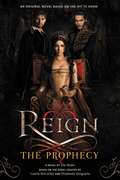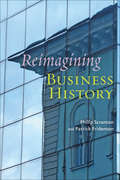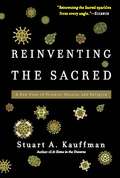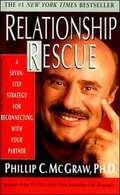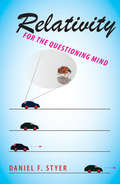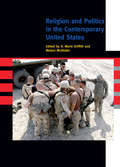- Table View
- List View
The Ravenous Brain: How the New Science of Consciousness Explains Our Insatiable Search for Meaning
by Daniel BorConsciousness is our gateway to experience: it enables us to recognize Van Gogh&’s starry skies, be enraptured by Beethoven&’s Fifth, and stand in awe of a snowcapped mountain. Yet consciousness is subjective, personal, and famously difficult to examine: philosophers have for centuries declared this mental entity so mysterious as to be impenetrable to science. In The Ravenous Brain, neuroscientist Daniel Bor departs sharply from this historical view, and builds on the latest research to propose a new model for how consciousness works. Bor argues that this brain-based faculty evolved as an accelerated knowledge gathering tool. Consciousness is effectively an idea factory—that choice mental space dedicated to innovation, a key component of which is the discovery of deep structures within the contents of our awareness. This model explains our brains&’ ravenous appetite for information—and in particular, its constant search for patterns. Why, for instance, after all our physical needs have been met, do we recreationally solve crossword or Sudoku puzzles? Such behavior may appear biologically wasteful, but, according to Bor, this search for structure can yield immense evolutionary benefits—it led our ancestors to discover fire and farming, pushed modern society to forge ahead in science and technology, and guides each one of us to understand and control the world around us. But the sheer innovative power of human consciousness carries with it the heavy cost of mental fragility. Bor discusses the medical implications of his theory of consciousness, and what it means for the origins and treatment of psychiatric ailments, including attention-deficit disorder, schizophrenia, manic depression, and autism. All mental illnesses, he argues, can be reformulated as disorders of consciousness—a perspective that opens up new avenues of treatment for alleviating mental suffering. A controversial view of consciousness, The Ravenous Brain links cognition to creativity in an ingenious solution to one of science&’s biggest mysteries.
Reading Herodotus: A Guided Tour through the Wild Boars, Dancing Suitors, and Crazy Tyrants of The History
by Debra HamelDebra Hamel’s book is a lively introduction to The History of the Persian Wars, Herodotus's account of Persia's expansion under four kings—Cyrus, Cambyses, Darius, and Xerxes—and its eventual collision with the city-states of Greece. The History can be a long slog for modern readers, but it is full of salacious tales about sex, violent death, divine prophecies, and cannibals. Following the structure of the original work, Hamel leads the reader through a colorful tour of the central stories that compose The History. She highlights the more interesting and important parts of the story while providing readers who are new to Herodotus with the background information necessary to appreciate the author’s wide-ranging subject matter. At once academic and cheeky, the experience of this book is like reading Herodotus while simultaneously consulting a history of Greece and a scholarly commentary on the text.
Reading Herodotus: A Guided Tour through the Wild Boars, Dancing Suitors, and Crazy Tyrants of <I>The History</I>
by Debra HamelDebra Hamel’s book is a lively introduction to The History of the Persian Wars, Herodotus's account of Persia's expansion under four kings—Cyrus, Cambyses, Darius, and Xerxes—and its eventual collision with the city-states of Greece. The History can be a long slog for modern readers, but it is full of salacious tales about sex, violent death, divine prophecies, and cannibals. Following the structure of the original work, Hamel leads the reader through a colorful tour of the central stories that compose The History. She highlights the more interesting and important parts of the story while providing readers who are new to Herodotus with the background information necessary to appreciate the author’s wide-ranging subject matter. At once academic and cheeky, the experience of this book is like reading Herodotus while simultaneously consulting a history of Greece and a scholarly commentary on the text.
Ready: Why Women Are Embracing the New Later Motherhood
by Elizabeth GregoryOver the past three decades, skyrocketing numbers of women have chosen to start their families in their late thirties and early forties. Women now have the option to define for themselves when they are ready for a family, rather than sticking to a schedule set by social convention. In Ready, Elizabeth Gregory tracks the burgeoning trend of new later motherhood and demonstrates that waiting to have children has made many women better mothers thanks to increased self-awareness, greater financial power, and an ability to focus more on their families. Drawing on statistical evidence and in-depth interviews with more than 100 moms, Ready shatters the alarmist myths surrounding later motherhood. Without ignoring the complexities older women may face in their quest to have children, Gregory delivers surprising and welcome news that revolutionizes the way we think about motherhood. The 2012 paperback adds a new Preface bringing the data and analysis up to the moment: encompassing discussion of the recessionary birth rate drop among younger women and its longterm effect on the later motherhood trend, the intersections between the War on Women's Reproductive Choice and the US's family-unfriendly policies with the trend to delaying kids, the dynamics of fertility scaremongering, and the competing pro-natalist and anti-natalist pressures on American women today. The Preface also introduces new data from a range of researchers on the positive effects of delay on women's wages, long-term happiness, and political clout. This book examines the full range of pressures shaping women's fertility decisions today, and begins from the assumption that women's choices make sense, for them and for their families.
Reality Boy
by A.S. KingIn this fearless portrayal of a boy on the edge, highly acclaimed Printz Honor author A.S. King explores the desperate reality of a former child "star" struggling to break free of his anger.Gerald Faust started feeling angry even before his mother invited a reality TV crew into his five-year-old life. Twelve years later, he's still haunted by his rage-filled youth--which the entire world got to watch from every imaginable angle--and his anger issues have resulted in violent outbursts, zero friends, and clueless adults dumping him in the special education room at school. No one cares that Gerald has tried to learn to control himself; they're all just waiting for him to snap. And he's starting to feel dangerously close to doing just that...until he chooses to create possibilities for himself that he never knew he deserved.
The Rebel of Rangoon: A Tale of Defiance and Deliverance in Burma
by Delphine SchrankOne of Kirkus Reviews Best Books of 2015 An epic, multigenerational story of courage and sacrifice set in a tropical dictatorship, The Rebel of Rangoon captures a gripping moment of possibility in Burma (Myanmar)Once the shining promise of Southeast Asia, Burma in May 2009 ranks among the world's most repressive and impoverished nations. Its ruling military junta seems to be at the height of its powers. But despite decades of constant brutality-and with their leader, the Nobel Peace Prize-laureate Aung San Suu Kyi, languishing under house arrest-a shadowy fellowship of oddballs and misfits, young dreamers and wizened elders, bonded by the urge to say no to the system, refuses to relent. In the byways of Rangoon and through the pathways of Internet cafes, Nway, a maverick daredevil; Nigel, his ally and sometime rival; and Grandpa, the movement's senior strategist who has just emerged from nineteen years in prison, prepare to fight a battle fifty years in the making.When Burma was still sealed to foreign journalists, Delphine Schrank spent four years underground reporting among dissidents as they struggled to free their country. From prison cells and safe houses, The Rebel of Rangoon follows the inner life of Nway and his comrades to describe that journey, revealing in the process how a movement of dissidents came into being, how it almost died, and how it pushed its government to crack apart and begin an irreversible process of political reform. The result is a profoundly human exploration of daring and defiance and the power and meaning of freedom.
Rebellion in Black and White: Southern Student Activism in the 1960s
by Robert Cohen Dan T. Carter David J. SnyderRebellion in Black and White offers a panoramic view of southern student activism in the 1960s. Original scholarly essays demonstrate how southern students promoted desegregation, racial equality, free speech, academic freedom, world peace, gender equity, sexual liberation, Black Power, and the personal freedoms associated with the counterculture of the decade. Most accounts of the 1960s student movement and the New Left have been northern-centered, focusing on rebellions at the University of California, Berkeley, Columbia University, and others. And yet, students at southern colleges and universities also organized and acted to change race and gender relations and to end the Vietnam War. Southern students took longer to rebel due to the south’s legacy of segregation, its military tradition, and its Bible Belt convictions, but their efforts were just as effective as those in the north. Rebellion in Black and White sheds light on higher education, students, culture, and politics of the American south. Edited by Robert Cohen and David J. Snyder, the book features the work of both seasoned historians and a new generation of scholars offering fresh perspectives on the civil rights movement and many others.Contributors: Dan T. CarterDavid T. FarberJelani FavorsWesley HoganChristopher A. HuffNicholas G. MeriwetherGregg L. MichelKelly MorrowDoug RossinowCleveland L. Sellers Jr.Gary S. SprayberryMarcia G. SynnottJeffrey A. TurnerErica WhittingtonJoy Ann Williamson-Lott
Rebellion in Black and White: Southern Student Activism in the 1960s
by Robert Cohen David J. Snyder Dan T. CarterRebellion in Black and White offers a panoramic view of southern student activism in the 1960s. Original scholarly essays demonstrate how southern students promoted desegregation, racial equality, free speech, academic freedom, world peace, gender equity, sexual liberation, Black Power, and the personal freedoms associated with the counterculture of the decade. Most accounts of the 1960s student movement and the New Left have been northern-centered, focusing on rebellions at the University of California, Berkeley, Columbia University, and others. And yet, students at southern colleges and universities also organized and acted to change race and gender relations and to end the Vietnam War. Southern students took longer to rebel due to the south’s legacy of segregation, its military tradition, and its Bible Belt convictions, but their efforts were just as effective as those in the north. Rebellion in Black and White sheds light on higher education, students, culture, and politics of the American south. Edited by Robert Cohen and David J. Snyder, the book features the work of both seasoned historians and a new generation of scholars offering fresh perspectives on the civil rights movement and many others.Contributors: Dan T. CarterDavid T. FarberJelani FavorsWesley HoganChristopher A. HuffNicholas G. MeriwetherGregg L. MichelKelly MorrowDoug RossinowCleveland L. Sellers Jr.Gary S. SprayberryMarcia G. SynnottJeffrey A. TurnerErica WhittingtonJoy Ann Williamson-Lott
Rebuild the Dream
by Van JonesIn Rebuild the Dream, green economy pioneer Van Jones reflects on his journey from grassroots outsider to White House insider. For the first time, he shares intimate details of his time in government – and reveals why he chose to resign his post as a special advisor to the Obama White House.Jones puts his hard-won lessons to good use, proposing a powerful game plan to restore hope, fix our democracy and renew the American Dream. The American Dream means different things to people, but the center of gravity is always the same: an ordinary person—who was not born with great wealth, but who is willing to work hard and play by the rules—should be able to find employment, live in a good community, make progress financially, retire with dignity, and give his or her children a better life. That dream is fading. On Main Street, too many people are working harder than ever – while falling further behind. They play by the rules, but cannot succeed. At the same time, other Americans, including the worst of Wall Street, break every rule, but cannot fail – because someone has already decided that they are &“too big&” to fail. The American Dream has been turned upside down and inside out. It is time to set things right. As the first Obama administration official to write a book about his experiences, Jones offers a unique perspective. In explaining why the 2008 &“hope&” bubble burst, he unveils the seven biggest mistakes made by the White House and its supporters. He explores the origin and fate of the movements that helped to elect President Obama, as well as those that have challenged and shaped his presidency. Along the way, Jones systematically reveals surprising parallels between Obama&’s people-powered campaign, the Tea Party and Occupy Wall Street. At this pivotal moment, Jones argues that we must make our economy respect the 99% and work for the 100%, not just the 1%. He proposes serious solutions that fit the scale of our problems. Rebuild the Dream sets forth bold ideas inspired by the progressive values that made the twentieth century the &“American Century.&” It shows how key public policies and investments can create millions of good, American jobs. America is still the best idea in the world. The American middle class is still her greatest invention. Rebuild the Dream is dedicated to the proposition that – with the right strategy– both can be preserved and strengthened for generations to come.
Reconfiguring the World: Nature, God, and Human Understanding from the Middle Ages to Early Modern Europe (Johns Hopkins Introductory Studies in the History of Science)
by Margaret J. OslerChange in human understanding of the natural world during the early modern period marks one of the most important episodes in intellectual history. This era is often referred to as the scientific revolution, but recent scholarship has challenged traditional accounts. Here, in Reconfiguring the World, Margaret J. Osler treats the development of the sciences in Europe from the early sixteenth to the late seventeenth centuries as a complex and multifaceted process.The worldview embedded in modern science is a relatively recent development. Osler aims to convey a nuanced understanding of how the natural world looked to early modern thinkers such as Galileo, Descartes, Boyle, and Newton. She describes investigation and understanding of the natural world in terms that the thinkers themselves would have used. Tracing the views of the natural world to their biblical, Greek, and Arabic sources, Osler demonstrates the impact of the Renaissance recovery of ancient texts, printing, the Protestant Reformation, and the exploration of the New World. She shows how the traditional disciplinary boundaries established by Aristotle changed dramatically during this period and finds the tensions of science and religion expressed as differences between natural philosophy and theology.Far from a triumphalist account, Osler’s story includes false starts and dead ends. Ultimately, she shows how a few gifted students of nature changed the way we see ourselves and the universe.
Red Dynamite: Creationism, Culture Wars, and Anticommunism in America (Religion and American Public Life)
by Carl R. WeinbergIn Red Dynamite, Carl R. Weinberg argues that creationism's tenacious hold on American public life depended on culture-war politics inextricably embedded in religion. Many Christian conservatives were convinced that evolutionary thought promoted immoral and even bestial social, sexual, and political behavior. The "fruits" of subscribing to Darwinism were, in their minds, a dangerous rearrangement of God-given standards and the unsettling of traditional hierarchies of power. Despite claiming to focus exclusively on science and religion, creationists were practicing politics. Their anticommunist campaign, often infused with conspiracy theory, gained power from the fact that the Marxist founders, the early Bolshevik leaders, and their American allies were staunch evolutionists. Using the Scopes "Monkey" Trial as a starting point, Red Dynamite traces the politically explosive union of Darwinism and communism over the next century. Across those years, social evolution was the primary target of creationists, and their "ideas have consequences" strategy instilled fear that shaped the contours of America's culture wars. By taking the anticommunist arguments of creationists seriously, Weinberg reveals a neglected dimension of antievolutionism and illuminates a source of the creationist movement's continuing strength. Thanks to generous funding from Indiana University and its participation in TOME (Toward an Open Monograph Ecosystem), the ebook editions of this book are available as Open Access volumes from Cornell Open (cornellpress.cornell.edu/cornell-open) and other repositories.
Red Grouse (Large Print)
by Rnib BookshareThis is a Red Grouse shown from the side. There is a locator dot shown, which will be at the top left of the page when the image is the right way up. Its head, which is facing to the left, has a short blunt beak. One eye is visible, and above this, is its distinctive red wattle. Slightly down and to the right of the head is the wing. Down from this is the Grouse's chest, and down again are its two sturdy legs. To the very right of the picture its short tail can be found. The Red Grouse is covered with chestnut brown feathers.
Red Rover: Inside the Story of Robotic Space Exploration, from Genesis to the Mars Rover Curiosity
by Roger WiensFor centuries humankind has fantasized about life on Mars, whether it’s intelligent Martian life invading our planet (immortalized in H.G. Wells’s The War of the Worlds) or humanity colonizing Mars (the late Ray Bradbury’s The Martian Chronicles). The Red Planet’s proximity and likeness to Earth make it a magnet for our collective imagination. Yet the question of whether life exists on Mars-or has ever existed there-remains an open one. Science has not caught up to science fiction-at least not yet.This summer we will be one step closer to finding the answer. On August 5th, Curiosity-a one-ton, Mini Cooper-sized nuclear-powered rover-is scheduled to land on Mars, with the primary mission of determining whether the red planet has ever been physically capable of supporting life. In Getting to Mars, Roger Wiens, the principal investigator for the ChemCam instrument on the rover-the main tool for measuring Mars’s past habitability-will tell the unlikely story of the development of this payload and rover now blasting towards a planet 354 million miles from Earth.ChemCam (short for Chemistry and Camera) is an instrument onboard the Curiosity designed to vaporize and measure the chemical makeup of Martian rocks. Different elements give off uniquely colored light when zapped with a laser; the light is then read by the instrument’s spectrometer and identified. The idea is to use ChemCam to detect life-supporting elements such as carbon, nitrogen, and oxygen to evaluate whether conditions on Mars have ever been favorable for microbial life.This is not only an inside story about sending fantastic lasers to Mars, however. It’s the story of a new era in space exploration. Starting with NASA’s introduction of the Discovery Program in 1992, smaller, scrappier, more nimble missions won out as behemoth manned projects went extinct. This strategic shift presented huge opportunities-but also presented huge risks for shutdown and failure. And as Wiens recounts, his project came close to being closed down on numerous occasions. Getting to Mars is the inspiring account of how Wiens and his team overcame incredible challenges-logistical, financial, and political-to successfully launch a rover in an effort to answer the eternal question: is there life on Mars?
Reflections on Uneven Democracies: The Legacy of Guillermo O'Donnell
by Daniel Brinks Marcelo Leiras Scott MainwaringThe third wave of democratization produced a wealth of enduring social science. Beginning in the 1970s, it prompted scholars to develop important theories on authoritarian breakdowns and transitions to democracy. No one in the field was more influential than Guillermo O’Donnell (1936–2011), whose pathbreaking work shaped the scholarship of generations of social scientists. Reflections on Uneven Democracies honors the legacy of O’Donnell’s research by advancing debates related to his work on democracy. Drawing together a veritable Who’s Who of eminent scholars—including two of O’Donnell’s closest collaborators, Philippe Schmitter and Laurence Whitehead—the volume examines issues related to democratic breakdowns and stability, the nature and quality of new democracies, institutional strength, the rule of law, and delegative democracy.This reexamination of some of the most influential arguments about democracy of the past forty years leads to original approaches and insights for a new era of democracy studies. Students of democracy and institutional performance, both Latin Americanists and comparativists more generally, will find this essential reading.
Reflections on Uneven Democracies: The Legacy of Guillermo O'Donnell
by Scott Mainwaring Daniel Brinks Marcelo LeirasThe third wave of democratization produced a wealth of enduring social science. Beginning in the 1970s, it prompted scholars to develop important theories on authoritarian breakdowns and transitions to democracy. No one in the field was more influential than Guillermo O’Donnell (1936–2011), whose pathbreaking work shaped the scholarship of generations of social scientists. Reflections on Uneven Democracies honors the legacy of O’Donnell’s research by advancing debates related to his work on democracy. Drawing together a veritable Who’s Who of eminent scholarsâ€�including two of O’Donnell’s closest collaborators, Philippe Schmitter and Laurence Whiteheadâ€�the volume examines issues related to democratic breakdowns and stability, the nature and quality of new democracies, institutional strength, the rule of law, and delegative democracy.This reexamination of some of the most influential arguments about democracy of the past forty years leads to original approaches and insights for a new era of democracy studies. Students of democracy and institutional performance, both Latin Americanists and comparativists more generally, will find this essential reading.
Reign: Darkness Rises
by Lily BlakeFind out how the Darkness rose to power in this digital original short story based on the hit CW television show, Reign.Long before Mary's reign, another power ruled over France. Born from blood and terror, it was called the Darkness. Now the Darkness has returned, and Bash is determined to stop it from spreading through the land before it can destroy the people he loves most.Word Count: 9,500
Reign: Darkness Rises
by Lily BlakeFind out how the Darkness rose to power in this digital original short story based on the hit CW television show, Reign. Long before Mary's reign, another power ruled over France. Born from blood and terror, it was called the Darkness. Now the Darkness has returned, and Bash is determined to stop it from spreading through the land before it can destroy the people he loves most.
Reign: The Haunting
by Lily BlakeAn original e-novella, based on the hit CW television show, Reign.It has been months since the death of King Henry II and the French court has grown accustomed to the rule of the newly-crowned King Francis. But while the people are excited by the prospects of a new reign, Francis struggles with his new place on the throne. Plagued by frequent nightmares of his father, he grapples with his guilt and grief. But as his visions become more threatening, Francis must wonder: Is his father's ghost trying to tell him something? Or is Francis, like Henry, slowly going mad?
Reign: Hysteria (Reign Ser. #2)
by Lily BlakeFrance is aflame with rumors of witchcraft and treachery. Who will be burn for their transgressions? Find out in this haunting original novel based on the hit CW television show, Reign.Something sinister has been sweeping the villages surrounding the French court. Rumors of Satan's horsemen traveling the countryside and claiming the souls of villagers have sent the people reeling into a religious frenzy and soon fear and suspicion lead them to accuse a young girl of witchcraft. After the prisoner is brought to the palace for questioning, Mary, Greer, Kenna, and Lola work to prove her innocence. But there are others who will stop at nothing to see the girl and her secrets silenced forever...
Reign: The Prophecy (Reign Ser. #1)
by Lily BlakeDeath has come to court. As the plague rages outside the palace walls, tormented screams and pleas for help go unanswered by the members of the French court sheltered within the castle. Mary Queen of Scots feels safe-but she doesn't know that someone using the secret tunnels may bring the threat inside. Mary worries that those she loves--her husband Francis, and friends Lola, Bash, and Kenna--remain stranded beyond the gates, among the sick and dying. The infection doesn't distinguish between royals and commoners. Can they survive? And when Nostradamus receives a disturbing vision that portends Mary's own death, she wonders--how long will she reign?
Reimagining Business History
by Philip Scranton Patrick FridensonBusiness history needs a shake-up, Philip Scranton and Patrick Fridenson argue, as many businesses go global and cultural contexts become critical. Reimagining Business History prods practitioners to take new approaches to entrepreneurial intentions, company scale, corporate strategies, local infrastructure, employee well-being, use of resources, and long-term environmental consequences.During the past half century, the history of American business became an unusually active and rewarding field of scholarship, partly because of the primacy of postwar American capital, at home and abroad, and the rise of a consumer culture but also because of the theoretical originality of Alfred D. Chandler. In a field long given over to banal company histories and biographies of tycoons, Chandler took the subject seriously enough to ask about the large patterns and causes of corporate success. Chandler and his students found the richest material for theorizing about the course of business history in large companies and their institutional structures and cultures. Meantime, Scranton and others found smaller firms, those specializing in batch work as opposed to mass-produced goods, far closer to the norm and more telling.Scranton and Fridenson believe that the time has come for a sweeping rethinking of the field, its materials, and the kinds of questions its practitioners should be asking. How can this field develop in an age of global markets, growing information technology, and diminishing resources? A transnational collaboration between two senior scholars, Reimagining Business History offers direction in forty-four short, pithy essays.
Reinventing the Sacred: A New View of Science, Reason, and Religion
by Stuart A. KauffmanConsider the complexity of a living cell after 3.8 billion years of evolution. Is it more awesome to suppose that a transcendent God fashioned the cell at a stroke, or to realize that it evolved with no Almighty Hand, but arose on its own in the changing biosphere?In this bold and fresh look at science and religion, complexity theorist Stuart Kauffman argues that the qualities of divinity that we revere-creativity, meaning, purposeful action-are properties of the universe that can be investigated methodically. He offers stunning evidence for this idea in an abundance of fields, from cell biology to the philosophy of mind, and uses it to find common ground between belief systems often at odds with one another.A daring and ambitious argument for a new understanding of natural divinity, Reinventing the Sacred challenges readers both scientifically and philosophically.
Relationship Rescue: A Seven-Step Strategy for Reconnecting with Your Partner
by Phillip C. McGrawAs a follow-up to his bestselling book Life Strategies, Oprah acolyte Phillip C. McGraw, Ph.D., moves from aiding the aimless individual to coaching the disconnected couple. McGraw has distilled his more than two decades of counseling experience into a seven-step strategy he calls "Relationship Rescue.""I'm prepared to kick a hole in the wall of the pain-ridden, unhappy maze you've gotten yourself into, and provide you clear access to action-oriented answers and instructions on what you must do to have what you want," says Dr. Phil. His aim is to expose and eliminate the saboteurs that cause senseless damage to already-fragile marriages, and, like an emotional root canal, to replace them with values he says provide positive results. If you follow Dr. Phil's strategy, he will lead you on a precise journey to uncover your heart and then share it with your partner as part of taking the "risk of intimacy."Dr. Phil leads you to "reconnect with your core" in the first five steps of his seven-step strategy. By no means a quick fix, there are in-depth and rigorous questionnaires, surveys, tests, and profiles that require a "brutally candid" mindset, with such fill-in-the-blanks as "List five things that today would make you fall out of love with your partner." With this internal work accomplished, you'll then move on to reconnecting with your partner during a two-week, half-hour-a-day short course. As a "dyad," you and your loved one take turns giving monologues on topics such as "The most positive thing I took away from my mother and father's relationship was..."Once the "reconnection" has been established, Dr. Phil says the work shifts to a management role, as relationships are always a work in progress. Dr. Phil humorously refers to his own marriage throughout the book, sharing his mishaps and victories in learning to accept and enjoy what he sees as fundamental but complementary differences between men and women. --John Youngs
Relativity for the Questioning Mind
by Daniel F. StyerTo those of us who are not mathematicians or physicists, Einstein’s theory of relativity often seems incomprehensible, exotic, and of little real-world use. None of this is true. Daniel F. Styer’s introduction to the topic not only shows us why these beliefs are mistaken but also shines a bright light on the subject so that any curious-minded person with an understanding of algebra and geometry can both grasp and apply the theory.Styer starts off slowly and proceeds carefully, explaining the concepts undergirding relativity in language comprehensible to nonscientists yet precise and accurate enough to satisfy the most demanding professional. He demonstrates how the theory applies to various real-life situations with easy equations and simple, clear diagrams. Styer's classroom-tested method of conveying the core ideas of relativity—the relationship among and between time, space, and motion and the behavior of light—encourages questions and shows the way to finding the answers. Each of the book’s four parts builds on the sections that come before, leading the reader by turn through an overview of foundational ideas such as frames of reference, revelatory examples of time dilation and its attendant principles, an example-based exploration of relativity, and explanations of how and why gravity and spacetime are linked. By demonstrating relativity with practical applications, Styer teaches us to truly understand and appreciate its importance, beauty, and usefulness.Featuring worked and end-of-chapter problems and illustrated, nontechnical explanations of core concepts, while dotted throughout with questions and answers, puzzles, and paradoxes, Relativity for the Questioning Mind is an enjoyable-to-read, complete, concise introduction to one of the most important scientific theories yet discovered. The appendixes provide helpful hints, basic answers to the sample problems, and materials to stimulate further exploration.
Religion and Politics in the Contemporary United States (A Special Issue of<I> American Quarterly</I> <I> </I>)
by R. Marie Griffith Melani McAlisterThis collection of essays from a special issue of American Quarterly explores the complex and sometimes contradictory ways that religion matters in contemporary public life.Religion and Politics in the Contemporary United States offers a groundbreaking, cross-disciplinary conversation between scholars in American studies and religious studies. The contributors explore numerous modes through which religious faith has mobilized political action. They utilize a variety of definitions of politics, ranging from lobbying by religious leaders to the political impact of popular culture. Their work includes the political activities of a very diverse group of religious believers: Christians, Jews, Muslims, Hindus, Buddhists, and others. In addition, the book explores the meanings of religion for people who might contest the term—those who are spiritual but not religious, for example, as well as activists who engage symbols of faith and community but who may not necessarily consider themselves members of a specific religion. Several essays also examine the meanings of secular identity, humanist politics, and the complex evocations of civil religion in American life.No other book on religion and politics includes anything like the diversity of religions, ethnicities, and topics that this one does—from Mormon political mobilization to attempts at Americanizing Muslims in the post-9/11 United States, from César Chávez to James Dobson, from interreligious cooperation and conflict over Darfur to the global politics surrounding the category of Hindus and South Asians in the United States.
